| Common name | Binomial name | Population | Status | Trend | Notes | Image |
|---|
| Coral-billed ground-cuckoo | Carpococcyx renauldi | unknown [34] | EN [34] |  [34] [34] | |  |
| Bornean ground-cuckoo | Carpococcyx radiceus | unknown [35] | VU [35] |  [35] [35] | |  |
| Giant coua | Coua gigas | unknown [36] | VU [36] |  [36] [36] | |  |
| Black-bellied malkoha | Phaenicophaeus diardi | unknown [37] | NT [37] |  [37] [37] | |  |
| Chestnut-bellied malkoha | Phaenicophaeus sumatranus | unknown [38] | NT [38] |  [38] [38] | | 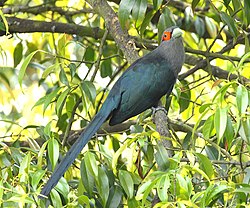 |
| Andaman coucal | Centropus andamanensis | unknown [39] | LC [39] |  [39] [39] | |  |
| Gabon coucal | Centropus anselli | unknown [40] | LC [40] |  | | 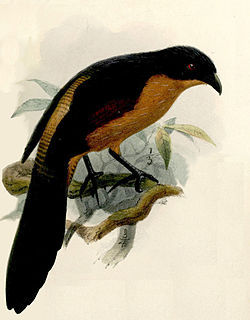 |
| Pied coucal (White-necked coucal) | Centropus ateralbus | unknown [41] | LC [41] |  [41] [41] | |  |
| Lesser coucal | Centropus bengalensis | unknown [42] | LC [42] |  [42] [42] | Several wide-ranging national estimates exist, but total population has not been quantified. [42] |  |
| Black-billed coucal (Lesser black coucal) | Centropus bernsteini | unknown [43] | LC [43] |  [43] [43] | |  |
| Bay coucal | Centropus celebensis | unknown [44] | LC [44] |  [44] [44] | |  |
| Coppery-tailed coucal | Centropus cupreicaudus | unknown [45] | LC [45] |  [45] [45] | | 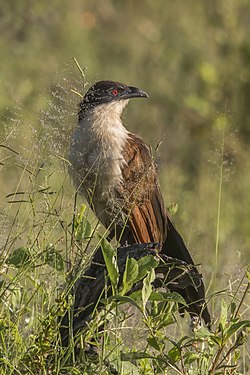 |
| Goliath coucal | Centropus goliath | unknown [46] | LC [46] |  [46] [46] | |  |
| Black coucal | Centropus grillii | unknown [47] | LC [47] |  [47] [47] | | 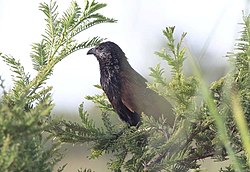 |
| Black-throated coucal | Centropus leucogaster | unknown [48] | LC [48] |  [48] [48] | |  |
| Black-faced coucal | Centropus melanops | unknown [49] | LC [49] |  [49] [49] | | 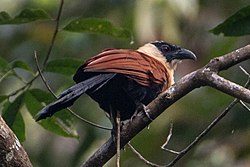 |
| Ivory-billed coucal (Greater black coucal) | Centropus menbeki | unknown [50] | LC [50] |  [50] [50] | |  |
| Buff-headed coucal | Centropus milo | unknown [51] | LC [51] |  [51] [51] | |  |
| Blue-headed coucal | Centropus monachus | unknown [52] | LC [52] |  [52] [52] | |  |
| Pheasant coucal | Centropus phasianinus | unknown [53] | LC [53] |  [53] [53] | |  |
| Senegal coucal | Centropus senegalensis | unknown [54] | LC [54] |  [54] [54] | |  |
| Greater coucal | Centropus sinensis | unknown [55] | LC [55] |  [55] [55] | Two wide-ranging national estimates exist, but total population has not been quantified. [55] |  |
| Kai coucal | Centropus spilopterus | unknown [56] | LC [56] |  [56] [56] | |  |
| White-browed coucal | Centropus superciliosus | unknown [57] | LC [57] |  [57] [57] | Note that IOC taxonomy splits an additional species, Burchell's coucal, from this species. [1] IUCN/BirdLife International maintain both within C. superciliosus. [20] |  |
| Malagasy coucal | Centropus toulou | unknown [58] | LC [58] |  [58] [58] | |  |
| Rufous coucal | Centropus unirufus | unknown [59] | LC [59] |  [59] [59] | |  |
| Philippine coucal | Centropus viridis | unknown [60] | LC [60] |  [60] [60] | |  |
| Chattering yellowbill (Blue malkoha) | Ceuthmochares aereus | unknown [61] | LC [61] |  [61] [61] | Note that IOC taxonomy splits an additional species, the green malkoha, from this species. [1] IUCN/BirdLife International maintain both within C. aereus. [20] |  |
| Horsfield's bronze-cuckoo | Chalcites basalis | unknown [62] | LC [62] |  [62] [62] | |  |
| Long-billed cuckoo | Chalcites megarhynchus | unknown [63] | LC [63] |  [63] [63] | |  |
| Black-eared cuckoo | Chalcites osculans | unknown [64] | LC [64] |  [64] [64] | |  |
| Diederik cuckoo | Chrysococcyx caprius | unknown [65] | LC [65] |  [65] [65] | |  |
| African emerald cuckoo | Chrysococcyx cupreus | unknown [66] | LC [66] |  [66] [66] | | 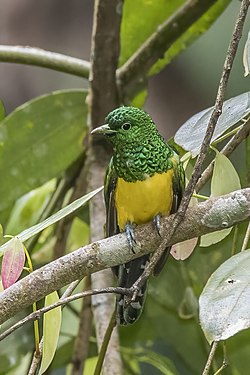 |
| Yellow-throated cuckoo | Chrysococcyx flavigularis | unknown [67] | LC [67] |  [67] [67] | |  |
| Klaas's cuckoo | Chrysococcyx klaas | unknown [68] | LC [68] |  [68] [68] | |  |
| Asian emerald cuckoo | Chrysococcyx maculatus | unknown [69] | LC [69] |  [69] [69] | |  |
| Violet cuckoo | Chrysococcyx xanthorhynchus | unknown [70] | LC [70] |  [70] [70] | |  |
| Chestnut-winged cuckoo | Clamator coromandus | unknown [71] | LC [71] |  [71] [71] | A wide-ranging national estimate exists for China, but total population has not been quantified. [71] |  |
| Jacobin cuckoo | Clamator jacobinus | unknown [72] | LC [72] |  [72] [72] | |  |
| Levaillant's cuckoo | Clamator levaillantii | unknown [73] | LC [73] |  [73] [73] | |  |
| Ash-colored cuckoo | Coccycua cinerea | unknown [74] | LC [74] |  [74] [74] | |  |
| Dwarf cuckoo | Coccycua pumila | unknown [75] | LC [75] |  [75] [75] | |  |
| Pearly-breasted cuckoo | Coccyzus euleri | unknown [76] | LC [76] |  [76] [76] | |  |
| Grey-capped cuckoo | Coccyzus lansbergi | unknown [77] | LC [77] |  [77] [77] | |  |
| Hispaniolan lizard-cuckoo | Coccyzus longirostris | unknown [78] | LC [78] |  [78] [78] | |  |
| Dark-billed cuckoo | Coccyzus melacoryphus | unknown [79] | LC [79] |  [79] [79] | |  |
| Cuban lizard-cuckoo (Great lizard cuckoo) | Coccyzus merlini | unknown [80] | LC [80] |  [80] [80] | |  |
| Chestnut-bellied cuckoo | Coccyzus pluvialis | unknown [81] | LC [81] |  [81] [81] | |  |
| Jamaican lizard-cuckoo | Coccyzus vetula | unknown [82] | LC [82] |  [82] [82] | |  |
| Blue coua | Coua caerulea | unknown [83] | LC [83] |  [83] [83] | |  |
| Coquerel's coua | Coua coquereli | unknown [84] | LC [84] |  [84] [84] | |  |
| Crested coua | Coua cristata | unknown [85] | LC [85] |  [85] [85] | |  |
| Running coua | Coua cursor | unknown [86] | LC [86] |  [86] [86] | |  |
| Olive-capped coua | Coua olivaceiceps | unknown [87] | LC [87] |  [87] [87] | | 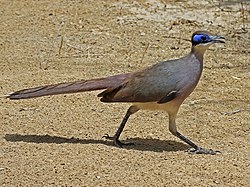 |
| Red-fronted coua | Coua reynaudii | unknown [88] | LC [88] |  [88] [88] | |  |
| Red-capped coua | Coua ruficeps | unknown [89] | LC [89] |  [89] [89] | |  |
| Red-breasted coua | Coua serriana | unknown [90] | LC [90] |  [90] [90] | |  |
| Verreaux's coua | Coua verreauxi | unknown [91] | LC [91] |  [91] [91] | |  |
| Scale-feathered malkoha | Dasylophus cumingi | unknown [92] | LC [92] |  [92] [92] | IUCN/BirdLife International place species in genus Lepidogrammus. [92] |  |
| Red-crested malkoha (Rough-crested malkoha) | Dasylophus superciliosus | unknown [93] | LC [93] |  [93] [93] | |  |
| Pavonine cuckoo | Dromococcyx pavoninus | unknown [94] | LC [94] |  [94] [94] | | 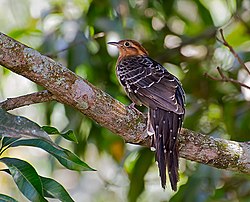 |
| Eastern koel (Pacific koel) | Eudynamys orientalis | unknown [95] | LC [95] |  [95] [95] | Note that IOC taxonomy splits an additional species, the black-billed koel, from this species. [1] IUCN/BirdLife International maintain both within E. orientalis. [20] |  |
| Western koel (Asian koel) | Eudynamys scolopaceus | unknown [96] | LC [96] |  [96] [96] | |  |
| Guira cuckoo | Guira guira | unknown [97] | LC [97] |  [97] [97] | |  |
| Red-billed ground-cuckoo | Neomorphus pucheranii | unknown [98] | LC [98] |  [98] [98] | |  |
| Rufous-winged ground-cuckoo | Neomorphus rufipennis | unknown [99] | LC [99] |  [99] [99] | |  |
| Dwarf koel | Microdynamis parva | unknown [100] | LC [100] |  [100] [100] | |  |
| Thick-billed cuckoo | Pachycoccyx audeberti | unknown [101] | LC [101] |  [101] [101] | |  |
| Chestnut-breasted malkoha | Phaenicophaeus curvirostris | unknown [102] | LC [102] |  [102] [102] | | 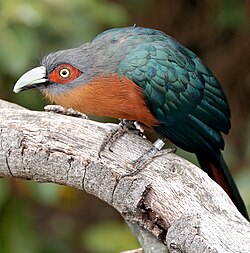 |
| Mentawai malkoha | Phaenicophaeus oeneicaudus | unknown [103] | LC [103] |  [103] [103] | | |
| Green-billed malkoha | Phaenicophaeus tristis | unknown [104] | LC [104] |  [104] [104] | |  |
| Blue-faced malkoha | Phaenicophaeus viridirostris | unknown [105] | LC [105] |  [105] [105] | |  |
| Common squirrel-cuckoo | Piaya cayana | unknown [106] | LC [106] |  [106] [106] | The global population has not been quantified due to recent taxonomic splits. [106] Note that IOC taxonomy maintains this species as a single species with P. mexicana. [1] |  |
| Mexican squirrel-cuckoo | Piaya mexicana | unknown [107] | LC [107] |  [107] [107] | The global population has not been quantified due to recent taxonomic splits. [107] Note that IOC taxonomy maintains this species as a single species with P. cayana. [1] |  |
| Black-bellied cuckoo | Piaya melanogaster | unknown [108] | LC [108] |  [108] [108] | |  |
| Yellow-billed malkoha | Rhamphococcyx calyorhynchus | unknown [109] | LC [109] |  [109] [109] | |  |
| Raffles's malkoha | Rhinortha chlorophaea | unknown [110] | LC [110] |  [110] [110] | |  |
| Channel-billed cuckoo | Scythrops novaehollandiae | unknown [111] | LC [111] |  [111] [111] | |  |
| Sirkeer malkoha | Taccocua leschenaultii | unknown [112] | LC [112] |  [112] [112] | |  |
| Long-tailed koel | Urodynamis taitensis | unknown [113] | LC [113] |  [113] [113] | |  |
| Red-billed malkoha | Zanclostomus javanicus | unknown [114] | LC [114] |  [114] [114] | |  |
|













































































































